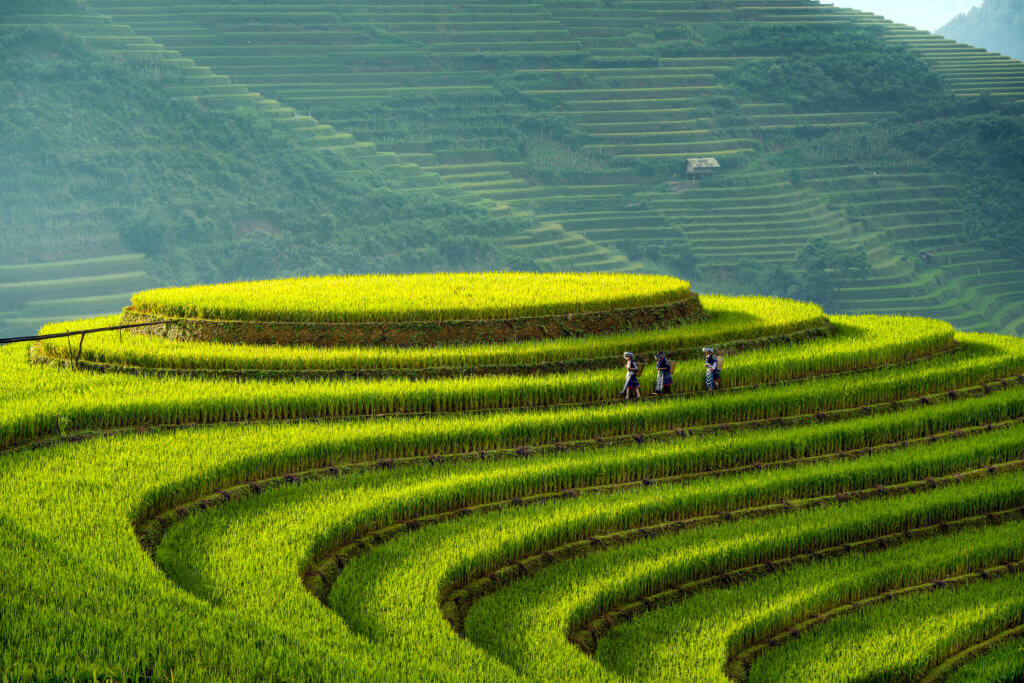Allianz Re | Agriculture Insurance in Asia: protection gap and embracing technology
March 9 2023

Agriculture remains the backbone of many Asian economies with 70% of Asia’s population living in rural areas and more than a third involved in agriculture.
However, farmers in the region face numerous challenges, including extreme weather events, natural disasters, pest outbreaks, livestock epidemics and diseases that threaten food security and the stability of local communities.
Strengthening agricultural productivity in Asia and the Pacific is crucial to reduce poverty, end hunger, improve nutrition and support development. In response, many countries in Asia are turning to agriculture insurance to mitigate the impact of these risks to ensure that farmers have the resources they need to continue producing food for their communities. It has become an important tool to provide a safety net to farmers, to help them adopt better practices and in many cases shift cropping patterns.
China and India are two of the most important agriculture-producing countries in the region. To put things in perspective, more than one third of the €35 billion (US$37 billion) estimated global agriculture insurance premium in 2021 was from Asia Pacific.
Protection gap of agriculture insurance in Asia
Agriculture insurance in China started in the 1950s, and in India, in an ad-hoc, scattered away, since 1970s. However, its development initially slowed down due to unfavourable social and economic conditions. In the 2000s, both governments began to support and promote agriculture insurance programmes, which led to more widespread adoption amongst farmers. As of 2003, the penetration rate for agriculture insurance was less than 0.05%.
By 2019, the penetration levels of both these countries reached the 40% range. However, there is still a wide section of the agricultural sector that remains unprotected.
Today, China has become the second largest agriculture insurance market globally, and India the third. For China, the original premium income has raised from US$700 million in 2007, when government resumed subsidy on agriculture insurance, to US$17 billion in 2022. Over 70% of the major crops and livestock are covered by insurance. In India the numbers are smaller from US$100 million in 2000 to US$4 billion in 2022, but from a reinsurance perspective the two markets are comparable in premium volume.
Yet, the intensity of the coverage remains low. As of 2021, the sums insured per mu for grain crops like corn, wheat and rice range from Rmb 300 to 400, which is translated to US$650-850 per hectare. However, the estimated total cost for these grain crops, depending on crop types and region, ranged from US$1,800 to US$2,500 per hectare. Some reports have estimated that the protection gap for China’s agriculture sector to be around US$200-250 billion, indicating the difference between the total economic losses related to agriculture sector caused by natural disaster and the insured loss. The same protection gap for India is in excess of US$50 billion reiterating the huge supply demand bottlenecks in the two large economies.
Protection gap is particularly significant for small-scale farmers, who often lack access to insurance or are unable to afford it. In response, both governments have taken steps to:
- increase the availability and affordability of agriculture insurance by strengthening institutional capacity through subsidies;
- improve quality and efficiency of service delivery;
- strengthen risk-sharing mechanisms by promoting reinsurance to support the insurance companies;
- enhance financial inclusion;
- strengthen consumer protection.
However, it remains a challenge to close the protection gap fully.
Challenges
There are several factors that inhibited the growth and development of agriculture insurance in these two regions
- 1. Access to insurance
(i) Lack of awareness: Insurance still remains a “push” product rather than a “pull” product. Even when agriculture insurance is free or compulsory, most farmers are not aware of their entitlement when faced with losses.
(ii) Distribution: The low presence of insurance companies and intermediaries in these areas have made it difficult for farmers to purchase insurance. - 2. Cost and Complexity of Insurance: Both these aspects are significant barriers to adoption, particularly for small-scale farmers who may not have the resources to pay for insurance. In addition, limited financial literacy and lack of awareness of insurance products have created further obstacle.
- 3. Untimely settlement of claims: For a farmer that lives on season-to-season income, and often borrows money to fund the production, timely settlement is key.
- 4. Lack of data: Accurate and up-to-date information is critical to the success of agriculture insurance. However, in many countries in Asia, there is a lack of reliable data on crop yields and other factors that impact food production. This makes it difficult for insurance companies to accurately assess risks and develop effective insurance products.
Allianz Re’s role and strategy
Allianz is a global financial services company that offers agriculture insurance as part of its portfolio of insurance products. The company provides insurance coverage for a range of agriculture risks, including crop damage caused by natural disasters, disease outbreaks and other factors that can impact food production.
Allianz Re, as the centre of competence for agriculture insurance of Allianz, is committed to promoting the use of technology in agriculture, and is actively working together with farmers, governments and other stakeholders in developing and implementing new technologies and customised products to meet the needs of the agriculture sector, as well as promoting food security and sustainable agriculture in emerging markets.
Agriculture accounts for 10% of the gross premium income of Allianz Re third-party businesses. Out of the four main market pillars, Asia accounts for two, China and India – which is in line with the market developments in this region. This reflects on how Allianz Re has positioned it’s strategy in the agriculture business globally.
Outlook for agriculture insurance in Asia
Agriculture insurance has a few overarching trends that will dominate in the future. However, the core of it all is the need to transform digitally at a faster rate.
The value chain can be divided into five parts:
- Remote sensing/monitoring of standing crop
- Decision support systems in terms of pricing analytics, forecasting
- Digitisation of platforms within insurance companies/banks that integrate sales, policy administration and claims
- Technology for on-ground assessment
- Precision farming-based technologies
Digital technologies help to generate tangible value across the crop insurance value chain. This value chain aids in improving risk assessment, reducing operational expenses and helping the farmer to reduce his financial burden.
India and China have their own distinct models to digitise their economies and both governments have been actively promoting the use of new technologies in agriculture insurance to further close the protection gap.
For both countries, remote sensing is being widely used in the agriculture sector to improve the accuracy and efficiency of insurance claims. Many of the nationwide insurance companies and agriculture insurance specialists leverage this technology for a comprehensive view as well as to obtain real-time status of crop conditions. Big data and artificial intelligence (AI) are also being promoted by many insurers to analyse historical weather data and predict the likelihood of future crop damage, allowing them to adjust agriculture activities to reduce potential losses.
In China, digital platforms and livestock biometrics have largely improved the accuracy and efficiency in livestock insurance for both policy issuing and claim payouts. In some cases, this technology is also being used for real-time tracking and managing the health as well as movements of livestock.
In India and China, mobile penetration is substantially higher. Mobile technology has been demonstrated to be powerful in improving accessibility to insurance for small-scale farmers. In India, where land holdings are fragmented and the rural infrastructure still has a long way to go, mobile phone is the tool for inclusion into the financial framework. Most Chinese and Indian insurers now have user-friendly mobile applications for the farmer to purchase insurance, file claims and receive payments, making the process more convenient and accessible.
The central governments are also devoted to further deepening the penetration of agriculture insurance. They have actively been aiding the agriculture industry by stimulating the sustainable development from all aspects, including but not limited to, implementing advanced technologies, conducting pilot studies to push for the total cost to be covered for the grain crops and continuously providing support to farmers. With the increased awareness of insurance and easier accessibility of products, agriculture insurance will achieve even more significant development in this region.
At Allianz Re, we will continue to be committed to provide our support to secure our customers future. With 130 years of history, the aim of Allianz Group as far as agriculture business is concerned is to build a globally diversified and sustainable portfolio. We provide reinsurance protection to both our group companies and to third-party customers.
With climate change and global warming, diversification and sustainability through reinsurance has become more important than before to manage volatility. At Allianz Re, we are focusing on three main technological areas – monitoring, forecasting and product development. We will continuously work with our partners in China and India to elevate our global expertise in these areas to the stakeholders.
 |
Sonia Rawal
P&C and Agriculture Client Manager, India
Email: [email protected] |
 |
Yu Qingyau
P&C and Agriculture Client Manager, China
Email: [email protected] |
-
QBE | Elevating customer experience, humanising claims: QBE Asia’s ‘Solutions in a Box’
Vastly improving turnaround times and personalising service delivery, QBE Asia’s award-winning, end-to-end bundled claims solutions is a game-changer for the insurance industry.
-
Beazley | What does cyber protection look like from day 1 to day 600 and beyond?
Cybersecurity is no longer just an IT concern, but a governance issue that belongs on the boardroom agenda.
-
Sedgwick | Preparing for the next storm
Insurance industry needs to recalibrate, invest in innovation and strengthen systems, talent and data practices.
-
Peak Re | From climate modelling to market opportunity: Forging a new clarity on Southeast Asia’s climate risk
Southeast Asia's protection gap: a crisis of clarity, not just capital
